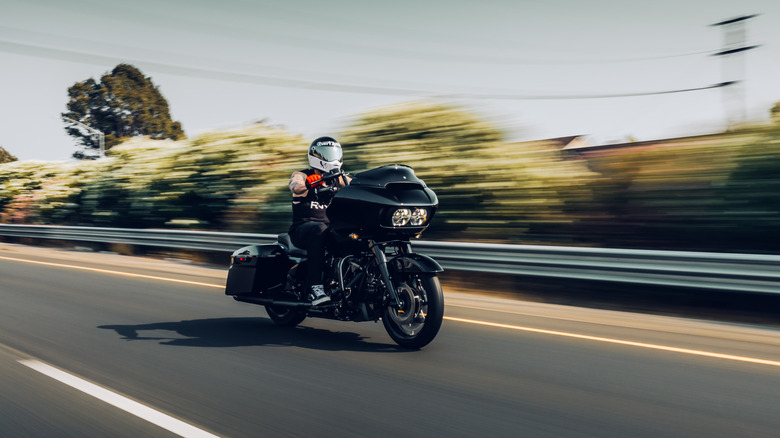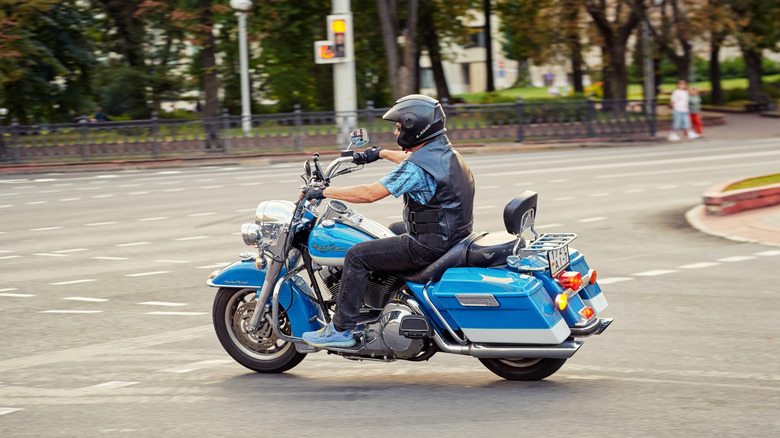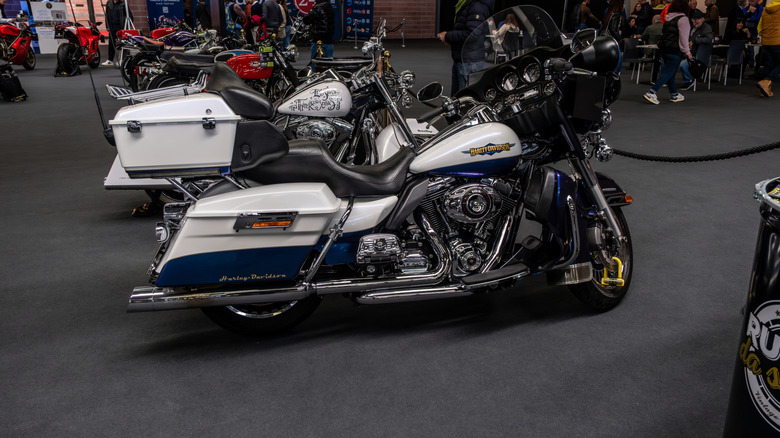Harley-Davidson Death Wobble: What Causes It And Which Models Are Affected?
If you ask a motorcyclist what their greatest fears are when riding, outside of a high-speed collision, there's a high chance they'll say it's a "death wobble." If you're wondering what the infamous phenomenon is; it's basically when a motorcycle begins to shake violently and uncontrollably, as if it were a bucking bull trying to throw you off its back.
It's generally not something caused by common motorcycle riding mistakes either, and while it can happen at any time, it's usually when you're at higher speeds. For Harley-Davidson owners, the event has happened frequently enough to earn its own name: the "Harley Wobble." For decades now, people have whispered about it at bike nights and even sought clarification on the occurrence via discussions on rider forums.
The wobble is real, not just a myth. People who ride Harleys have recounted experiences of the front end of their bikes whipping back and forth until the bike is almost impossible to control. Some people manage to keep it under control, whereas some people aren't as lucky. A rider from North Carolina even blamed the wobble for the crash of his 1999 Electra Glide Classic, which led to a lawsuit against the brand. There are still legal arguments going on, but the bigger question is what's really causing this scary shake, and which Harley models are more likely to experience it.
Why the wobble happens in the first place
What makes it so hard to pin down the cause of a Death Wobble is that there is not one single issue that can be attributed to the cause. When it comes to Harley-Davidson's motorcycles, people often point to the brand's rubber-mounted engine design and swingarm setup. The swingarm is the part of the bike that connects the rear wheel to the frame, and since it's bolted to the transmission instead of directly to the frame, any flex in the system can lead to instability. When the bike hits a certain speed or the wrong road conditions, that flex can cascade into a violent shake.
Design flaws don't tell the whole story. Simple things like riding on tires where the pressure is too low, worn bushings, or uneven saddlebag weight can nudge a stable motorcycle into dangerous territory. Even rider input matters, like gripping the bars too tightly during a shake often makes the wobble worse. And because Harley-Davidsons are some of the most customized bikes on the road, aftermarket suspension parts or swingarm changes can lead to a bike that now handles completely differently than its engineers intended.
If you ever find yourself having to confront the death wobble, which hopefully you will never have to do, experienced riders all say the same thing: Don't panic, keep your grip light, roll off the throttle gently, and let the bike settle itself down. If you'd rather try to prevent the situation from happening in the first place, installing aftermarket stabilizer kits and fork braces can help.
The Harley models most often linked to death wobble
The truth is, just about any motorcycle can start to shake if the conditions are right. For some Harley-Davidson models, the chances of it happening are concerningly higher. Riders who have experienced the dreaded wobble have called out touring bikes like the Electra Glide, Road King, and Ultra Classic as the main culprits. These are big, heavy machines designed to cover big miles. If something as small as their suspension, tires, or mounts isn't set up just right, that weight can make it harder for the rider to control.
The older versions of these models from the 1990s and early 2000s are considered to be the most susceptible to it given that the prevention technology has advanced, but reports haven't just come from that time period. If the setup is wrong or the bike is heavily loaded, even newer Harleys can start to wobble. The long history of the scary occurrence, coupled with the fact that it's happened across several models, speaks to the fact that this is not merely an isolated experience.
While some Harley models are notoriously difficult to ride, most of their bikes are promised to be comfortable and stable on the open road, making this a conflicting problem for fans. For riders, it's a reminder that even the most famous American cruiser isn't immune to physics. That's why regular maintenance, smart loading, and the right upgrades are still the best ways to protect yourself from one of the scariest things that can happen while riding a motorcycle.


